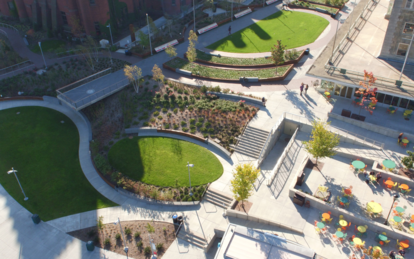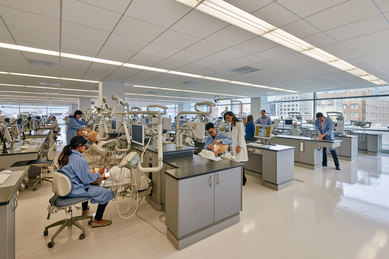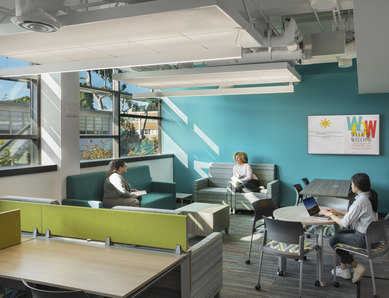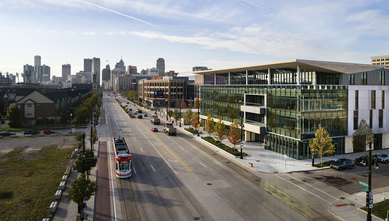离开校园对场所价值的启发

Across the country, typically boisterous campuses have all but closed to allow students, faculty and staff to retreat to their homes to safely practice social distancing. With students rushed off campus, dining halls, dormitories, classrooms, stadiums and research labs are all eerily silent.
The vast majority of colleges and universities have migrated their instruction online since social distancing practices began in the U.S. in response to the global COVID-19 pandemic. The retreat from campuses and pivot to teaching remotely presents a unique opportunity for us, as a higher education architect and a higher education design strategist, to contemplate the value of the physical campus. We are curious to use this time to explore what enabled institutions and students to quickly shift to virtual learning, the unrecognized benefits of online learning and uncover how we can improve campuses in the future.
Technology has the power to bridge physical distance, and online instruction may have benefits related to flexibility and convenience. Yet, as we live, work, learn and play from home, we are all discovering that virtual chats and video calls are not a one-for-one substitute for in-person connection and collaboration. As designers, we believe that place matters. Without access to a physical campus, students are missing a number of factors that set them up for long-term success.

In-person simulation spaces such as those at the University of the Pacific Arthur A. Dugoni School of Dentistry are challenging to reproduce online. The current public health crisis may inspire novel learning experiences that will prove valuable even after students return to campus.
Face-to-Face Interaction
Campuses offer experiential learning opportunities such as maker spaces, science labs and simulation rooms that are difficult, if not impossible, to replicate online. One discussion of the shift to virtual simulations was a webinar titled, “Transitioning to Online Interprofessional Education (IPE) in a Pandemic,” led by the National Center for Interprofessional Practice and Education (NEXUS). While COVID-19 pushes institutions to embrace virtual instruction, it is an opportunity to translate critical “hands-on” learning, leading us to develop improved experiences that will continue to benefit students when they are back on campus.
In addition to applied learning, these spaces encourage chance encounters and casual conversations with students or faculty members from different departments, potentially broadening each learner’s academic or career trajectory. Students on campus are more likely to participate in informal peer-to-peer learning and to be involved in faculty-led research projects. Students on campus are regularly presented a plethora of spontaneous social opportunities from meeting a friend in the dining hall to joining the student-run radio, and from taking part in intramural sports to volunteer and club activities. Face-to-face interactions help students build professional networks and friendships that last a lifetime. Will the relationships students build online be as rich, diverse and long-lasting without in-person, on-campus experiences?

Inviting breakout spaces support casual peer-to-peer learning and mentoring, improving both well-being and academic achievement.
Personal Discovery
For many students, the transition from life in their childhood home to a new independent life on campus defines the college experience. While the journey of “going away to college” is a characteristically American experience, it is a critical moment in the lives of many students. In creating a new home for newly independent students, the campus offers many opportunities for students to discover their personal identity and learn life skills for mental and physical well-being. The availability of career and behavioral counseling prepares students for the workplace and personal relationships. Recreation and wellness centers provide the means to establish beneficial habits such as nutritious eating, regular exercise and stress reduction techniques that build physical health and mental resilience, serving students long after they graduate. Faced by a lack of access to these services, how are students continuing their journey of personal discovery? Are they building mental resilience and learning new ways to accomplish their goals while remote from campus?

The Mike Ilitch School of Business at Wayne State University was strategically located in a prominent downtown location and designed to better connect students and leaders of the Detroit business community.
Community Connectivity
Most campuses are deeply embedded in the local community and students are part of the local educational and professional ecosystem that gives them the chance to connect with local industry leaders and to develop internship opportunities and career opportunities. Sharing a connection to a specific place and set of collective experiences tied by tradition builds a strong alumni network, often improving a student’s career prospects. This year, many summer internships will be going remote, underlining the value employers place on maintaining a pipeline of new talent. We are curious to discover if online internships will increase opportunities for students or if it will limit the learning benefits for students. What other community connections will be lost without access to a campus environment?
Unmatched Richness
University and college campuses offer a unique atmosphere that is a once in a lifetime experience. This extraordinary environment enables hands-on academic enrichment, personal discovery and establishes life-long social networks. In addition, the cities and towns where campuses are located provide ample opportunities for community service and as a result offer enriching real-life learning experiences, which are often equally, if not more, valuable and formative than what is learned in the classroom. While we expect to find that virtual instruction will have benefits for some learners who want or need additional flexibility, we believe in the power of place, and campuses provide a richness and depth of experience that cannot be fully captured online.
This is the first piece in our three-part series investigating how higher education learning environments are evolving in response to this public health crisis. We recognize that the situation is fluid, but we remain optimistic because higher education institutions take a long-term view. Colleges and universities are embracing change, and students have proven to be incredibly resilient during these unprecedented times. Leveraging our ongoing CampusForward research framework, alongside our clients we will be investigating the potential long-term impacts COVID-19 will have on higher education.